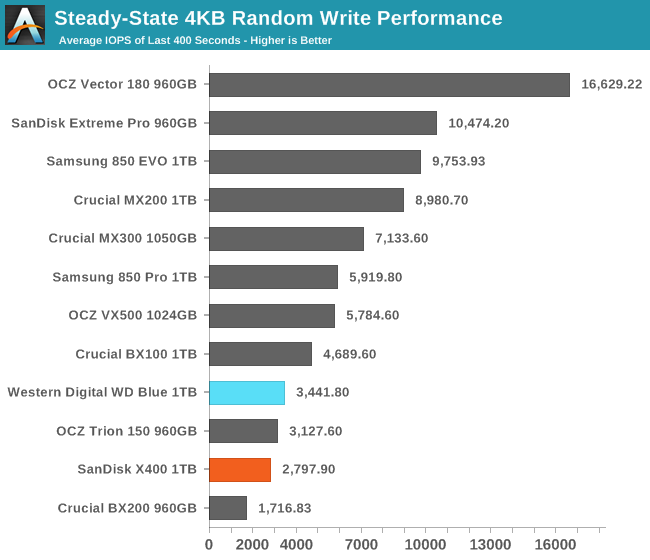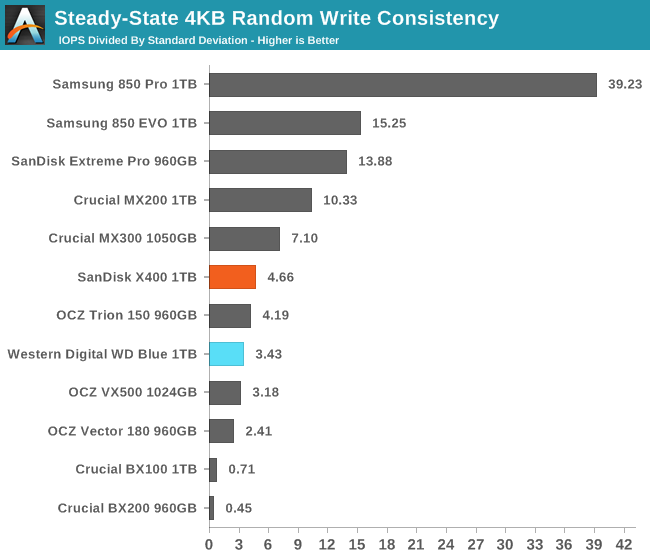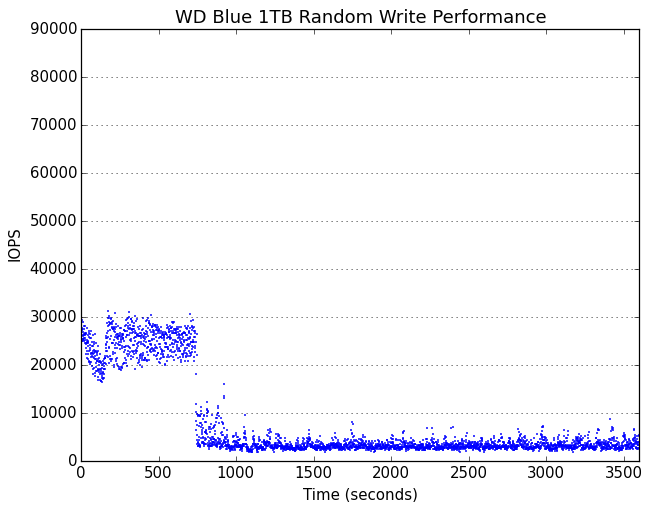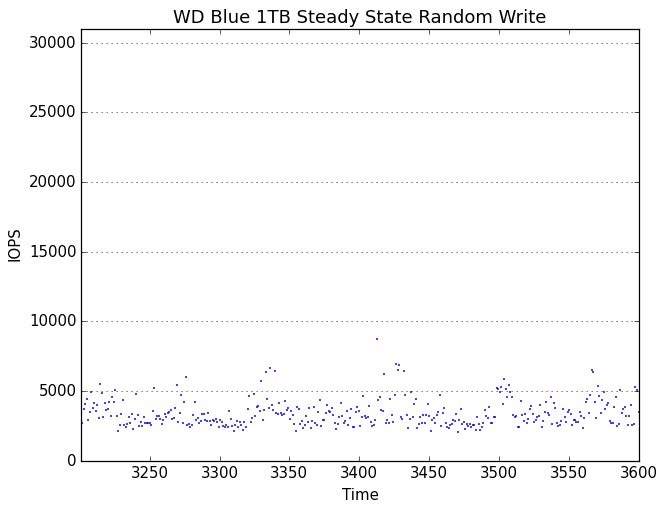The Western Digital Blue (1TB) SSD Review: WD Returns to SSDs
by Billy Tallis on October 11, 2016 8:00 AM EST- Posted in
- SSDs
- Storage
- Western Digital
- SanDisk
Performance Consistency
Our performance consistency test explores the extent to which a drive can reliably sustain performance during a long-duration random write test. Specifications for consumer drives typically list peak performance numbers only attainable in ideal conditions. The performance in a worst-case scenario can be drastically different as over the course of a long test drives can run out of spare area, have to start performing garbage collection, and sometimes even reach power or thermal limits.
In addition to an overall decline in performance, a long test can show patterns in how performance varies on shorter timescales. Some drives will exhibit very little variance in performance from second to second, while others will show massive drops in performance during each garbage collection cycle but otherwise maintain good performance, and others show constantly wide variance. If a drive periodically slows to hard drive levels of performance, it may feel slow to use even if its overall average performance is very high.
To maximally stress the drive's controller and force it to perform garbage collection and wear leveling, this test conducts 4kB random writes with a queue depth of 32. The drive is filled before the start of the test, and the test duration is one hour. Any spare area will be exhausted early in the test and by the end of the hour even the largest drives with the most overprovisioning will have reached a steady state. We use the last 400 seconds of the test to score the drive both on steady-state average writes per second and on its performance divided by the standard deviation.

With a slight increase in out of the box overprovisioning, it is unsurprising to see the WD Blue improve on the SanDisk X400's steady-state random write performance. The WD Blue overtakes the OCZ Trion 150 as the fastest planar TLC NAND SSD, but doesn't catch up to the MLC or 3D TLC drives.

The WD Blue has slightly worse performance consistency than the X400, but not low enough to be cause for concern.
 |
|||||||||
| Default | |||||||||
| 25% Over-Provisioning | |||||||||
Before reaching steady state, the WD Blue hovers between 20k and 30k IOPS, a significant improvement over the X400. Several other competitors have higher peak performance, but are either less consistent during the early phase of the test or don't last as long before dropping to steady state.
 |
|||||||||
| Default | |||||||||
| 25% Over-Provisioning | |||||||||
Upon reaching steady state, the WD Blue varies from roughly 2500 IOPS to 5000 IOPS, with short bursts of slightly higher performance. With extra overprovisioning the base performance of the WD Blue doesn't change but the upper limit of its normal band of performance increases to around 10k IOPS and the peaks reach 25k.










75 Comments
View All Comments
Decoherent - Friday, October 14, 2016 - link
There aren't a lot of reasons to use vendor-specific software (which often sucks) when you can use Macrium Reflect's free version, which is much more powerful. It's helped me sort out some other weird problems, too, such as fixing wrong UEFI entries that I couldn't figure out.jwcalla - Tuesday, October 11, 2016 - link
I don't think I would trust WD anything when it comes to storage.BrokenCrayons - Tuesday, October 11, 2016 - link
Why not? This is just a SanDisk drive with a few minor firmware tweaks. Besides that, WD was the industry leader before SSDs were a thing. Sure picking between Seagate, Quantum, Maxtor (omg that 4.3GB Bigfoot drive...how I missed your 3 months of dog slow performance before you started making the click o' death), and WD (I guess Toshiba and Hitachi too) was like picking between which rusty razor you'd prefer to slit your wrist with, but at least with WD drives you clould get a good gusher going before the blade broke.LordConrad - Tuesday, October 11, 2016 - link
I loved the Quantum Bigfoot, it was as great way to increase capacity for storage drives without having to wait for aerial density to increase.BrokenCrayons - Tuesday, October 11, 2016 - link
Oh the idea was sound. Going back to a 5.25 inch chassis to increase capacity seemed like a decent idea even though we'd long ago shifted to 3.5 inch drives. The problem with the Bigfoot was reliability. I had one I personally owned die on me and quite a few we sold to customers (12GB models) came back dead within less than 6 months. I remember all the hassles of getting RMAs done for those things. On the other hand, Quantum's 3.5 inch drives seemed fairly reliable. I wonder if there was a problem with heat expansion doing bad things to the read/write heads due to the larger platter size. It wasn't a problem with older 5.25 inch hard drives because they were usually full height and ran at a lower RPM than the Bigfoots.LordConrad - Tuesday, October 11, 2016 - link
I don't even remember what speed they ran at. Was it the full 5400rpm, or something slower like 5200 or 4900?BrokenCrayons - Wednesday, October 12, 2016 - link
I don't remember all the specs and had to look them up. The originals and the CY series ran at 3600 RPM and the TX, and TS series brought it up to 4000. If I recall correctly, when the Bigfoot was still in retail channels, a lot of 3.5 inch drives were ticking along at 3600 to 4200 RPM. 5400 RPM drives came along later and I don't know if Bigfoots were even in production when they were being sold as high performance storage solutions (well, non-SCSI drives anyhow...spindle speeds for SCSI devices were quite a bit higher).This is half from memory and the rest was from a couple of quick web searches so take all that with a grain of salt or two. I could be a bit off as it's been a long time.
mikato - Tuesday, October 11, 2016 - link
"I don't think I would trust anything when it comes to storage."That's better. Have backups that work.
But anyway, why all the dumping on WD? I don't think it is warranted.
barleyguy - Tuesday, October 11, 2016 - link
There have been many periods in the past where WD had very high failure rates. Because of that, many of us that have been around awhile have been bit in the butt by WD and don't trust them anymore. In the late 90s and early 2000s for instance, WD's failure rate was so high they had a wait queue and callback system set up for RMAs.That said, I think for last few years WD has been very good, so maybe it is unwarranted in the short term.
In particular I really like the WD Blue. They aren't fast, but they seem to be a very reliable drive, and throwing them in a RAID array with an SSD boot disk results in a pretty solid system.
Gigaplex - Tuesday, October 11, 2016 - link
Their main competitor, Seagate, has also had very high failure rates. Mikato was correct, don't trust any of them. There's no need to dump on WD more than the others.